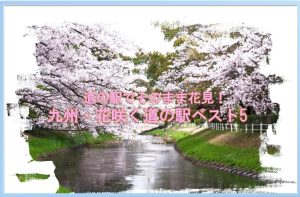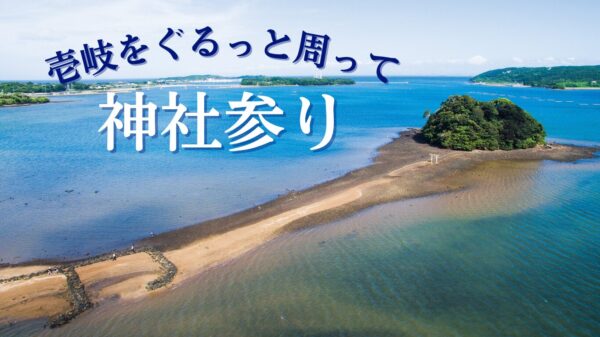2022 You can get there quickly from a roadside station in Kyushu! 21 Autumn Foliage Spots (Part 1)
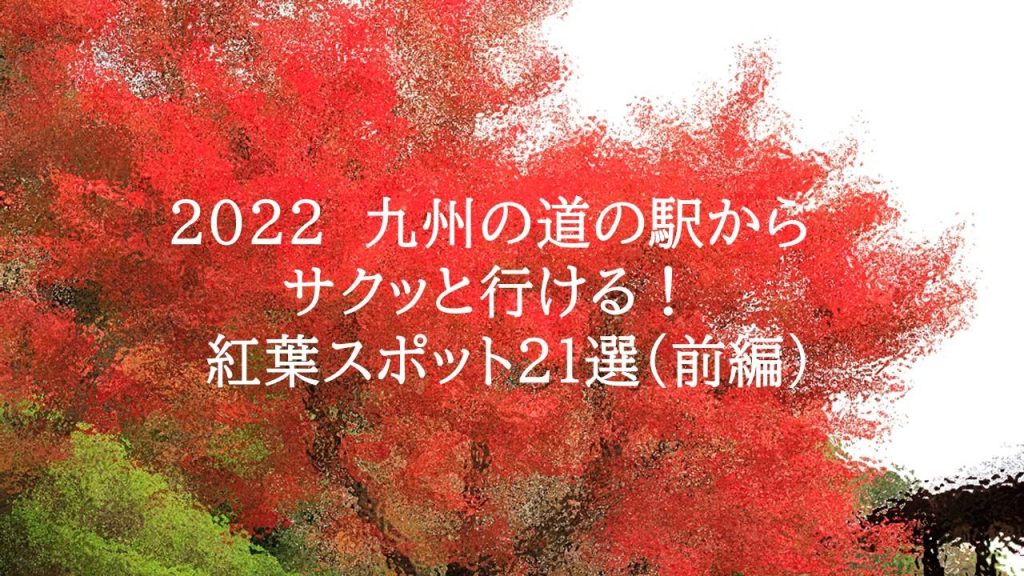
2022 21 Autumn Foliage Spots Quickly Accessible from Roadside Stations in Kyushu
Part 1 = Fukuoka and Saga Prefectures
Finally, the autumn foliage season is upon us. It's time to take a trip to enjoy the beautiful autumn leaves. Let us introduce autumn foliage spots where you can stop by on your way to and from a roadside station. From classic spots to hidden gems, the first part of this article will show you 11 places in Fukuoka and Saga prefectures that can be reached from a roadside station!
Roadside Station Harazuru, Roadside Station Ukiha
(1) Row of sumac trees at Enjuji Sone
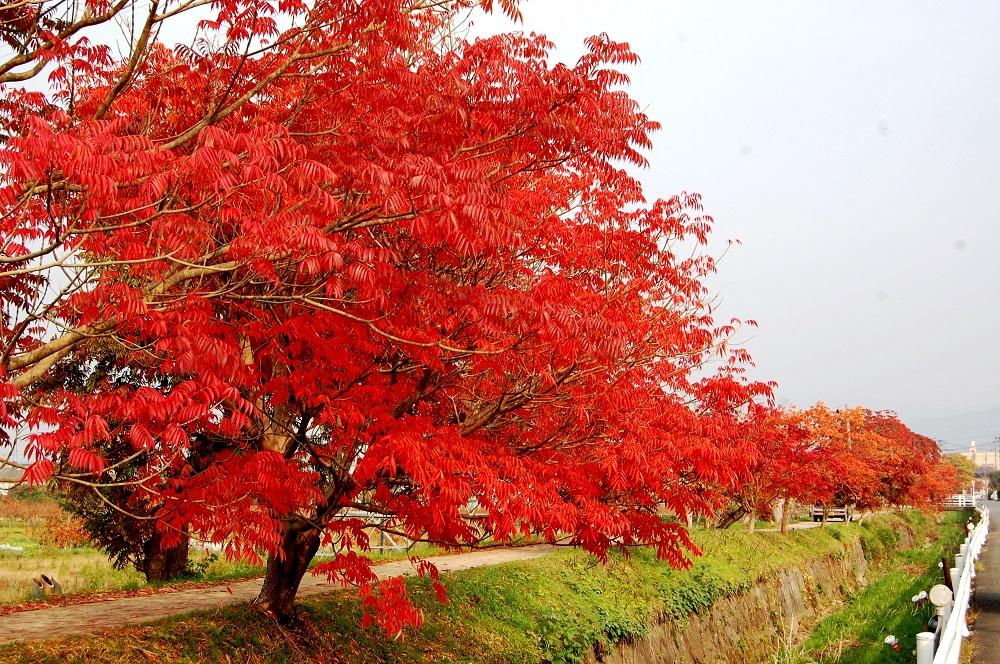
About 150 sumac trees are planted along the banks of Enjuji River for about 800 meters. From the middle of the Edo period to the beginning of the Showa period, wax was produced, and merchant houses with white walls and earthen storehouses were built with the proceeds. The rows of sumac trees along the Enju-ji Sone are the remnants of those days. During the season of vivid autumn leaves, the promenade attracts many visitors. During the autumn foliage season, the trees are lit up at night and visitors can enjoy viewing the beautiful autumn foliage of the sumac trees, which is different from that in the daytime, and various events are held on Saturday evenings. (Subject to change due to corona)
| Location | Fukumasu, Yoshii-cho, Ukiha-shi, Fukuoka |
|---|---|
| phone | 0943-76-9029(Ukiha Brand Promotion Division) |
| Access | 9 min. from to 9 min. from to 12 min. from to |
| supplementary information | Related URL:. Roadside Station Harazuru Roadside Station Ukiha |
Roadside Station Kurume
(2) Row of Japanese sumac trees in Yanagisaka Sone and (3) Ryubanzan Eishoji Temple
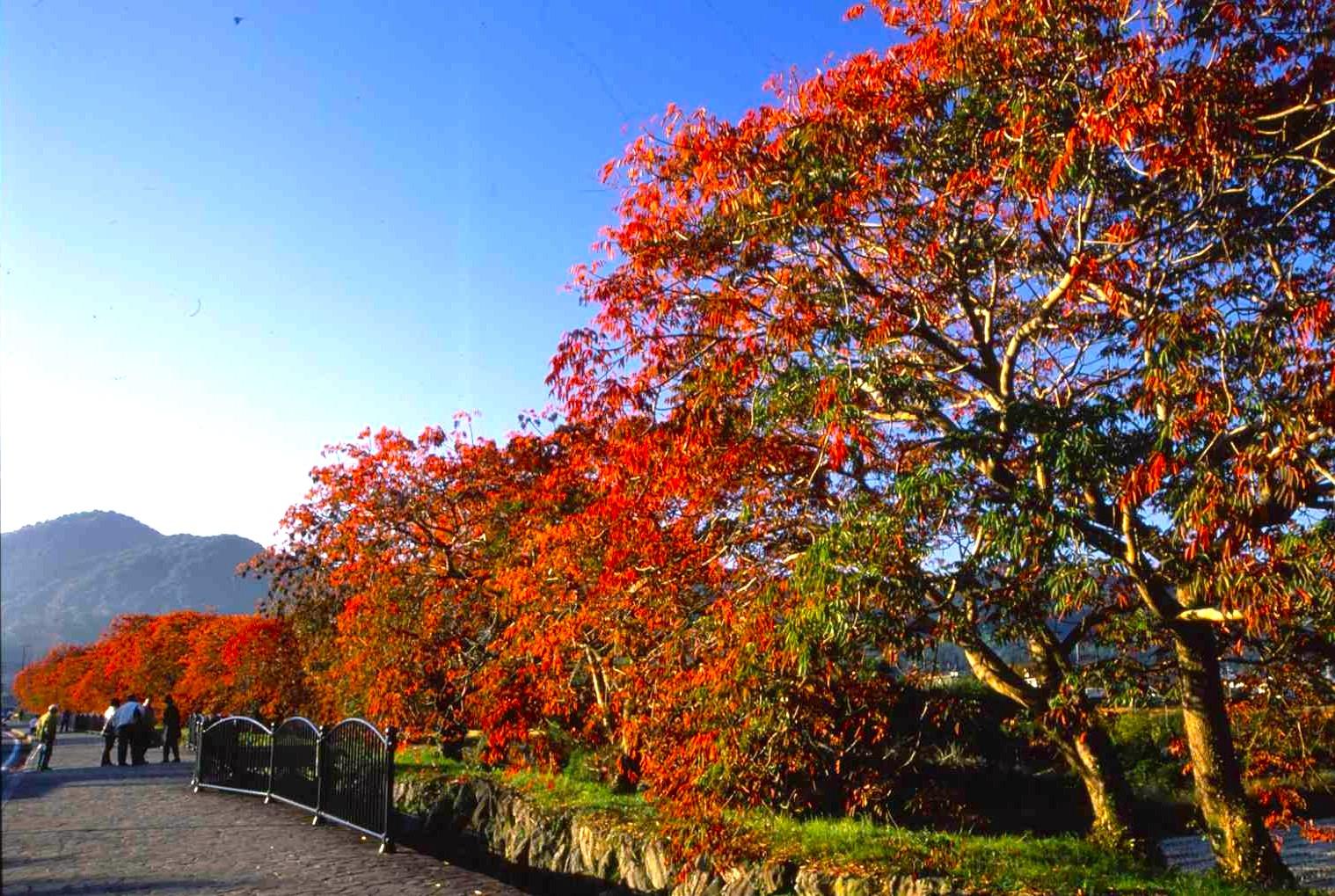
-1.jpg)
The rows of sumac trees along Yanagisaka Sone (photo above) were planted by the Kurume clan in 1724 as a source of wax for lamps. About 260 trees still exist, and are designated as a natural monument by the prefecture. The best time to view the autumn leaves is from mid-November to early December. About a 3-minute drive from this row of trees is "Yanagisaka-yama Eishoji Temple" (photo below), known as "Momiji-dera. The temple was founded in 680, the 9th year of Emperor Temmu, to pray for the empress' recovery from illness. The main deity is the Yakushi Nyorai (Medicine Buddha), and the temple is one of the three major Yakushi temples in Japan, along with "Izumo no Ichibata" and "Iyo no Yamada". The temple is famous for the beautiful maple trees spreading in the precincts. The yellow leaves of the gingko trees and the red leaves of the maple trees tell us that autumn is deepening.
Yanagisaka Goby Festival November 19 (Sat) - 27 (Sun), 2022
| name | Row of Japanese sumac trees in Yanagisaka Sone |
|---|---|
| Location | 2155 Yamamoto-cho, Kurume-shi, Fukuoka |
| phone | 0942-44-1386 |
| Access | 6 minutes from |
| supplementary information | Related URL:. Roadside Station Kurume Roadside Station Kurume |
Roadside Station Miyama
4) Kiyomizu Temple on Mt.
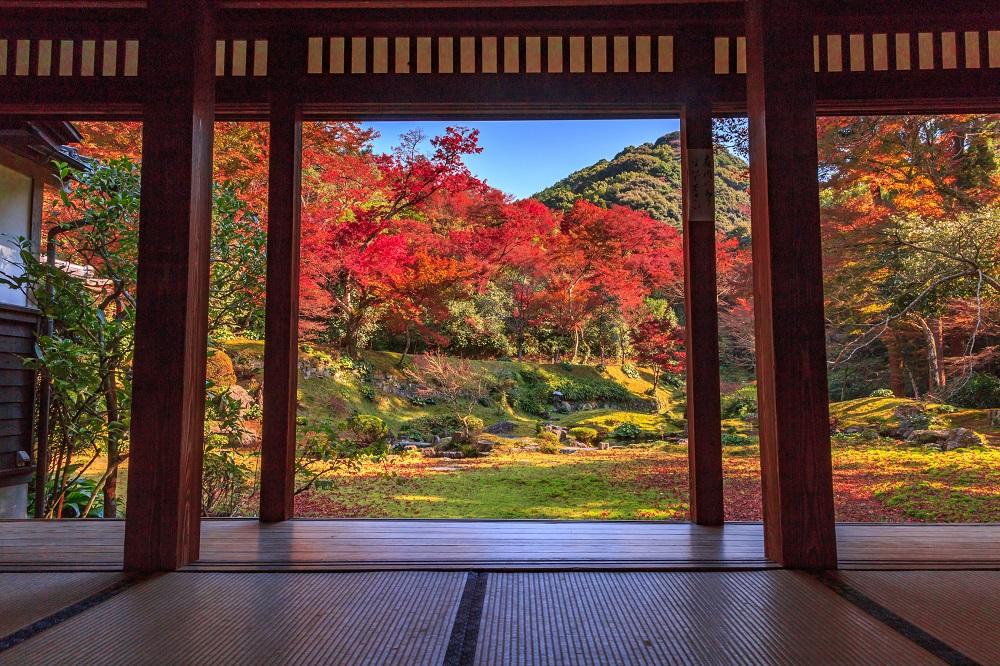
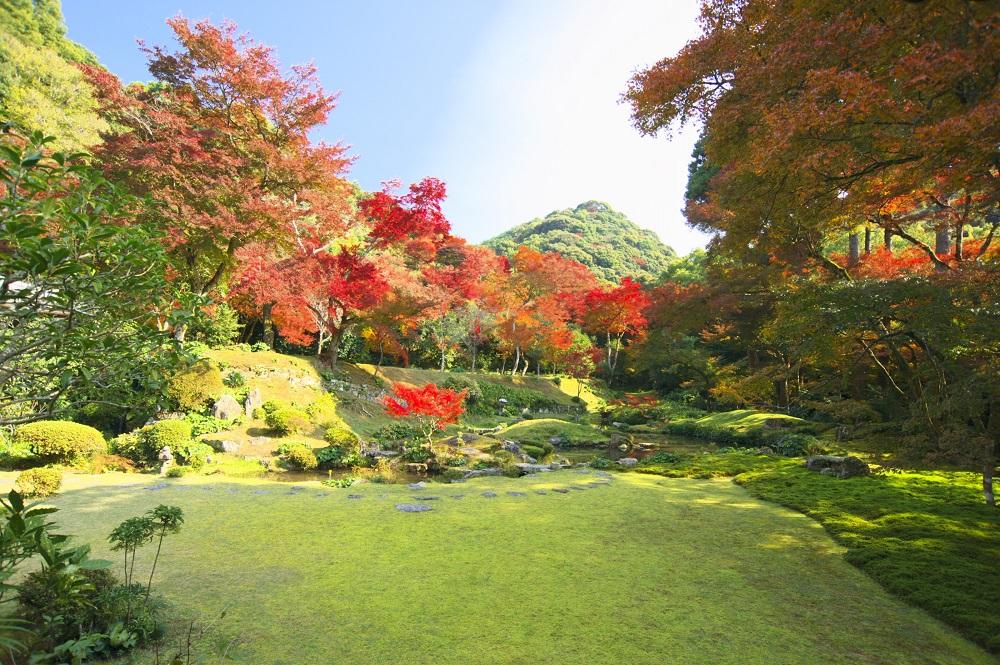
Motoyoshiyama Kiyomizu-dera Temple is an ancient temple with a history of more than 1,200 years, founded by Dengyo Daishi, the founder of the Tendai sect of Buddhism. The Honbo Garden, a nationally designated place of scenic beauty, is said to have been created in the Muromachi period (1336-1573) by the painter-monk Sesshu (1420-1506). The garden is a beautiful place to visit in spring, summer, fall, and winter, but it is especially beautiful in autumn, when the fresh green leaves and vivid colors of the trees are in full bloom. In front of the main temple is a large gingko tree, which becomes a carpet of golden leaves in the fall when the leaves turn yellow. Nearby stands a monument in the handwriting of Kitahara Hakushu. Other highlights include a three-story pagoda built in the Edo period, a 1,000-storied Buddha hall, and 500 arhats.
| Location | 1119-1 Motoyoshi, Setaka-cho, Miyama-shi, Fukuoka |
|---|---|
| phone | 0944-62-2001(Honbo)0944-63-7625(Temple Office) |
| Hours. | 9:00-17:00 (Honbo Garden) |
| Charge | 300 yen for adults, 100 yen for children (junior high school age and under) for garden preservation fee |
| regular closing day | Mondays (except holidays and during November) and 18th of each month |
| Access | 15 minutes from |
| supplementary information | Related URL:. Roadside Station Miyama Kiyomizu Temple Official Website |
Roadside Station Joyous House Hikosan
5) Hikosan Jingu Shrine and its surroundings
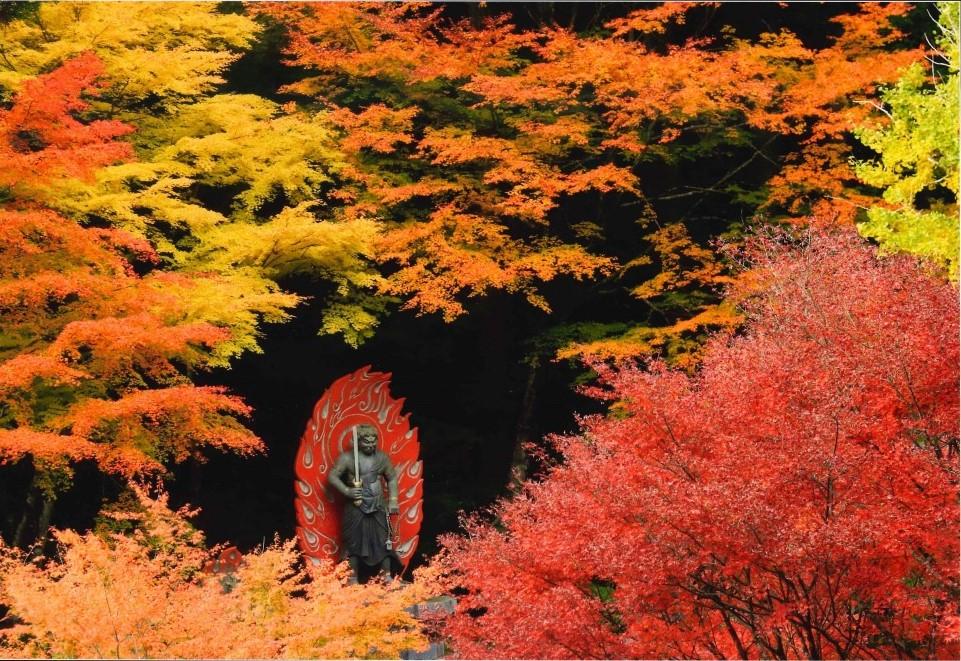
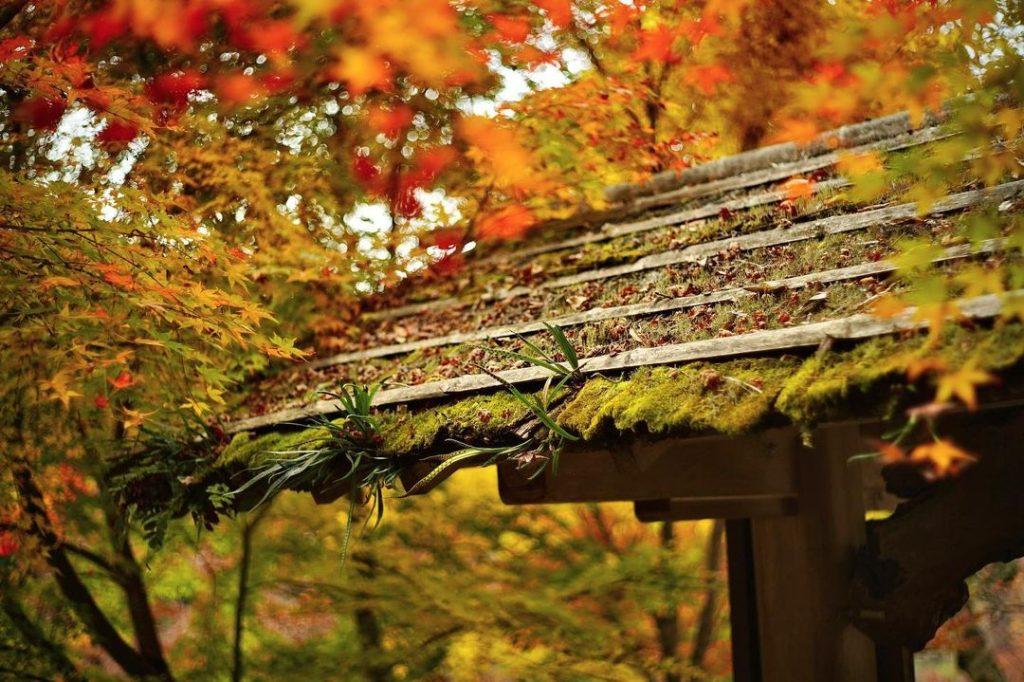
Mount Hikosan, which rises 1199 meters above sea level, is one of Japan's three most sacred mountains, along with Mount Haguro in Yamagata Prefecture and Mount Omine in Nara Prefecture. Hikosan Jingu is a sanctuary where Shugendo practitioners have trained. The shrine is located at the end of the 800 stone steps leading up from the copper torii (copper gate), and the sides of the approach are dotted with the remains of Shugendo lodgings. The maple and maple trees usually begin to change color from late October to mid-November around the Jomiya shrine on the summit of the mountain, and the further one goes to the foot of the mountain, the later the autumn colors become, so the longer the period of the season is for enjoying the autumn colors. From the top of the mountain, visitors can enjoy a magnificent view of the autumn foliage spreading out below. The autumn leaves in the garden of "Eichikozan Daigongen" at the foot of the mountain are also not to be missed.
| name | Hidehiko Shrine |
|---|---|
| Location | 1, Eihikoyama, Soeda-cho, Tagawa-gun, Fukuoka, Japan |
| phone | 0947-85-0001 |
| Hours of Prayer | 9:00-17:00 |
| Access | 24 minutes from |
| supplementary information | Related URL:. Hikosangu Shrine official website Roadside Station Joyous House Hikosan |
Roadside Station Yamato
6) Jukkaen
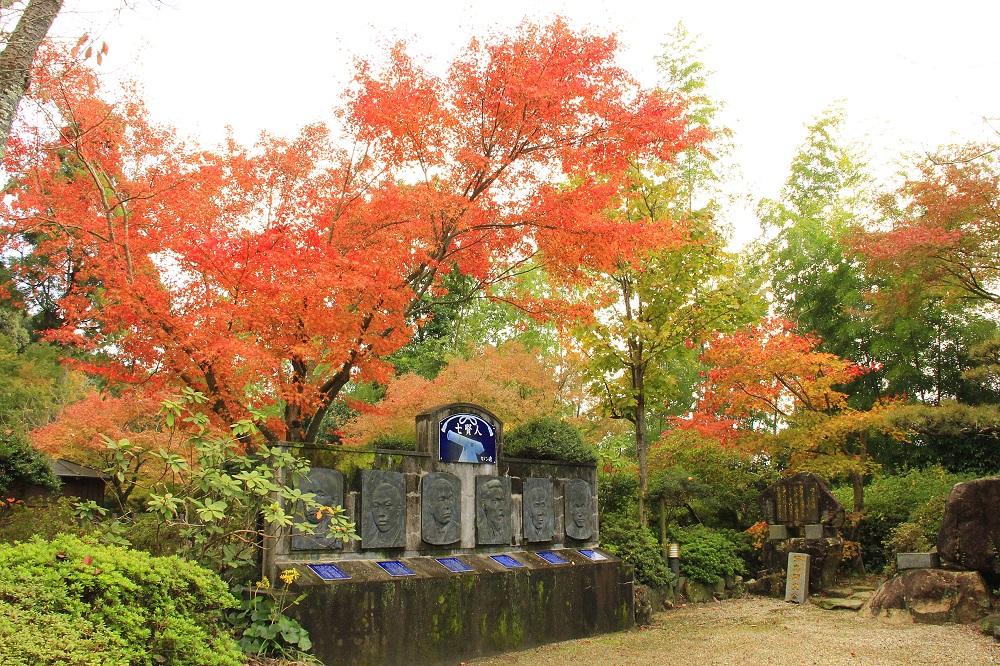
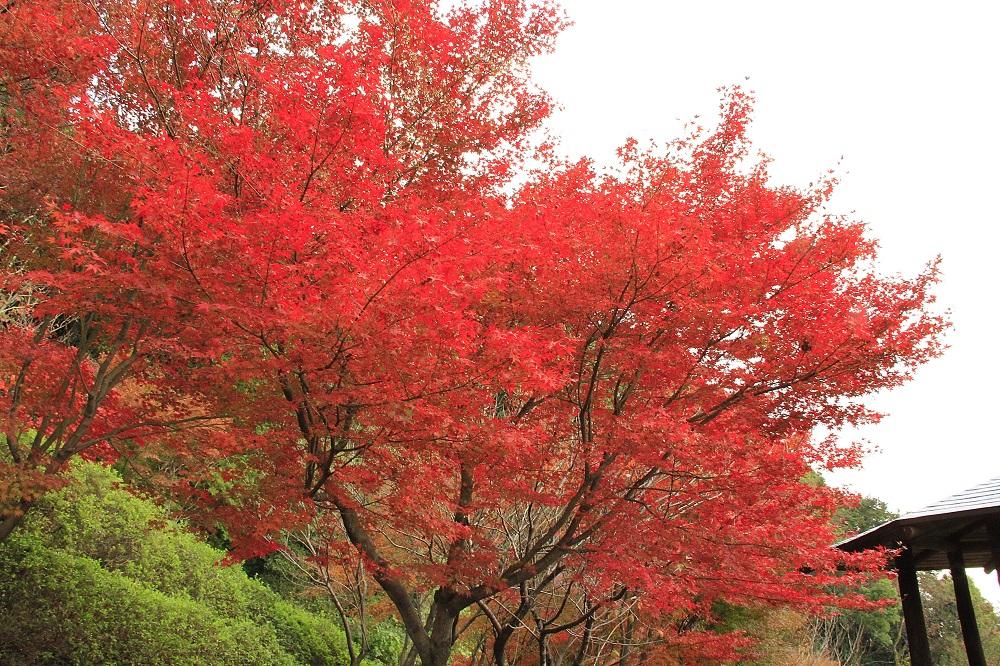
The garden at the former Nabeshima family villa site is open to the public only in spring when azaleas bloom and in autumn when the leaves change color. The garden was created over a period of 10 years using a vast former villa site of approximately 60,000 m2. The name "Jukatei" comes from the villa's name. The garden is planted with 10,000 rhododendrons and 30,000 azaleas, and in spring, the entire area is filled with flowers. In the fall, the park is decorated with autumn leaves. In addition, the garden was created by utilizing the slopes of the mountain, and the beauty of the garden can be enjoyed in a three-dimensional garden with artificial waterfalls and other features. In a corner of the park, there is a memorial museum for Harumi Tateishi, a local Japanese-style painter, whose paintings of beautiful women blend beautifully with the garden atmosphere.
| Location | 244-11 Umeno, Yamato-cho, Saga City, Saga Prefecture |
|---|---|
| phone | 0952-62-0012 |
| Hours. | 9:00-17:00 Open to the public during the fall foliage season in November (please inquire) |
| Charge | Adults 600 yen, Free for junior high school students and under Closed Please inquire for closure during the open season. |
| Access | 2 minutes from |
| supplementary information | Related URL:. Roadside Station Yamato |
Roadside Station Itsuki
(7) Forest of Environmental Art
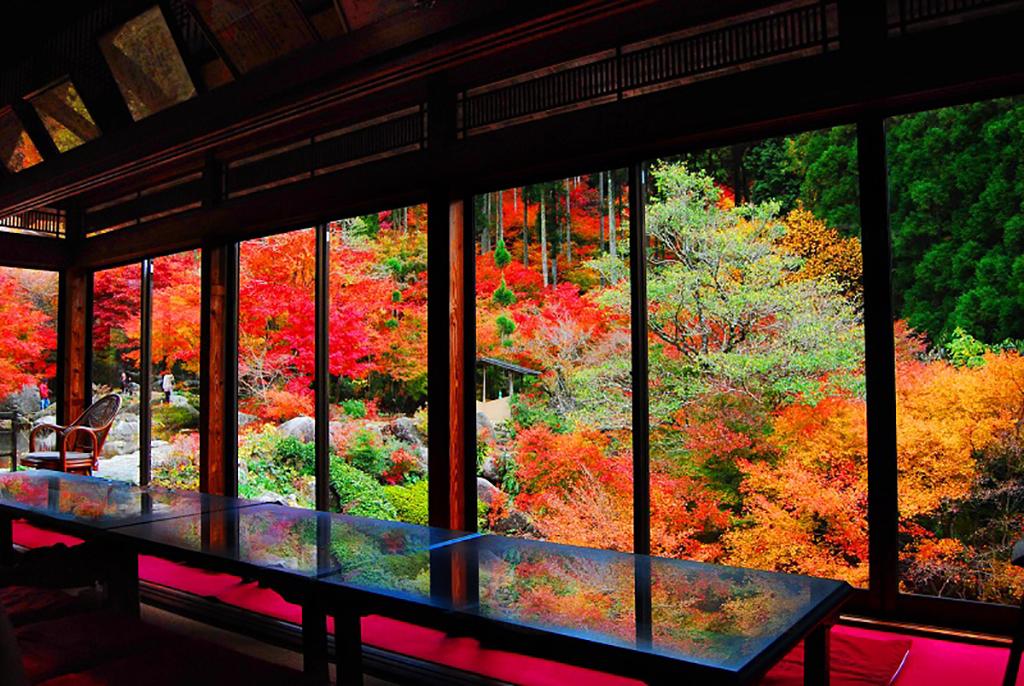
The "Forest of Environmental Art" is open to the public every year from mid-April to mid-June when the leaves are fresh green, and in November when they turn red. The "Maple Forest" was created by environmental artist Masaaki Tsuruta over a period of 40 years in a privately owned forest that stretches approximately 30 hectares on the southwestern slope of Mt. The view of the autumn foliage from the "Fuyu Sanso," a villa built from the scrap wood of an old house built 100 years ago, is like a painting in a single scroll! It is the most popular tree during the period when it is open to the public. There are many spots for strolling, including a large maple tree 8 meters high with a trunk circumference of 3 meters.
| Location | 667 Hirano, Itsuki-cho, Karatsu City, Saga Prefecture |
|---|---|
| phone | 0955-63-2433(Telephone reception hours: 9:00-16:00) |
| Hours. | 9:00-16:00 |
| Charge | Adults and high school students 700 yen, elementary and junior high school students 300 yen, free for infants |
| Access | 11 minutes from |
| supplementary information | Related URL:. Roadside Station Itsuki Forest of Environmental Art Official Site |
Roadside Station Itsuki
8) Seikei Park
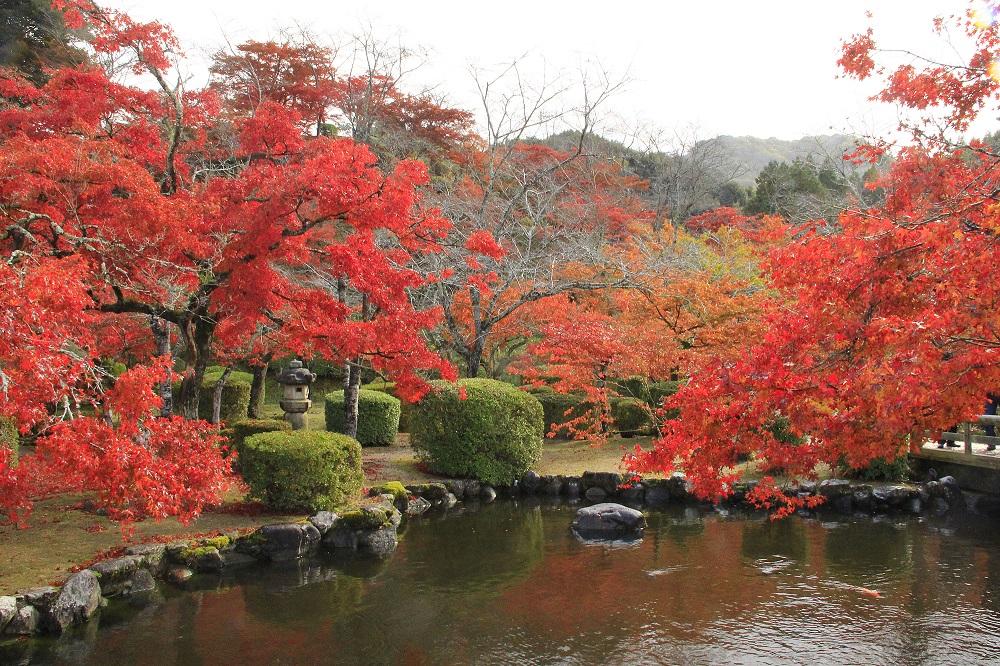
If you are heading toward Takeo from Michi no Eki Itsuki, "Seikei Park" in Taku City is also recommended. The former residence of the Taku domain's Taku family (retainer) was built in 1913 by Takatori Koreyoshi, a businessman who made his fortune in the coal mines, and donated it to Taku Village at that time. The park is named after his name "Seikei" (meaning "west ravine"). The public hall "Kan'ouitei" and the red brick library in the park were also donated by Takatori Iyoshi in 1915. The "Kanyingi-tei" was designated as a nationally registered tangible cultural property as a fine example of a wooden Japanese-style public hall building. The building is planted with plum trees, approximately 400 cherry trees, azaleas, and 180 maple trees, offering beauty in every season.
| Location | 1975-1 Nishinohara, Taku-cho, Taku-shi, Saga |
|---|---|
| phone | 0952-75-3002 |
| Hours. | 9:00-16:00 |
| Charge | free |
| Access | 10 minutes from |
| supplementary information | Related URL:. Roadside Station Itsuki |
Roadside Station Yoshinokaseri
(9) Kugen-an and (10) Niiyama Shrine
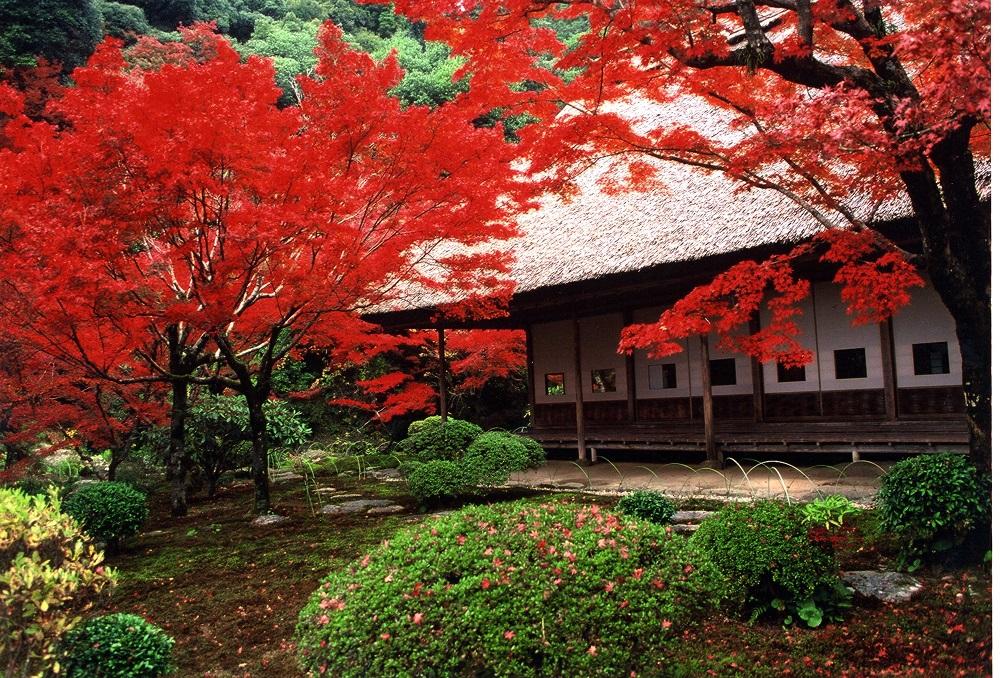
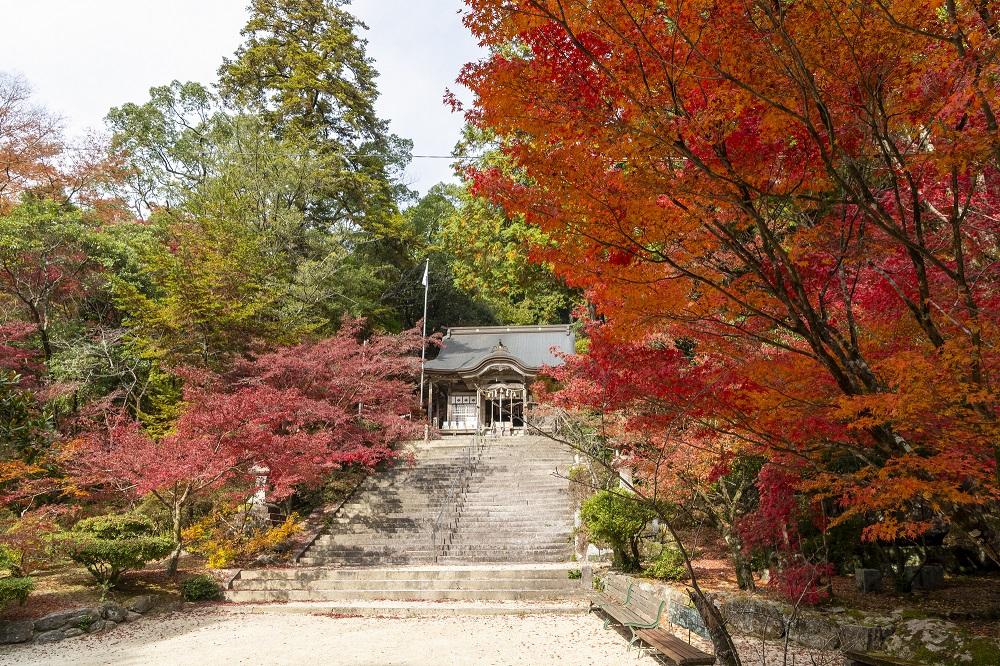
Designated by the national government as a place of scenic beauty, "Kyunen-an" (photo above) is the site of a villa built in 1892 by Yataro Itami, a member of a local conglomerate, on the site of Nibisan Jizoin, a pagoda and fudoin temple of Nibisan Gokokuji. The garden of approximately 6,800 m2 was created over a period of nine years by the monk Hori of Seigyo-ji Temple. The former tea ceremony house was named "Kyunen-an" (Nine Year Hermitage) in honor of the years spent in its construction. The villa and garden, built in the sukiya style, are planted mainly with maple and azalea trees, and are open to the public only during the season of fresh greenery in spring and autumn leaves in fall. The garden is open to the public only during the season of fresh green leaves in spring and the season of autumn leaves in fall, each lasting only nine days. Therefore, the public viewing period from November 15 to 23 attracts a large number of visitors. (Photo courtesy of the Saga Prefecture Tourism Federation)
The autumn foliage at the Nibiyama Shrine (photo below), located behind the Kugen-an Hermitage, is also not to be missed. The approach to the shrine is through the Niomon Gate of Mt. The approach to the shrine is also beautiful in autumn when the leaves turn red. The shrine has been worshipped as the god of mountains and agriculture for more than 1,200 years. The autumn colors of the approximately 1,000 maple trees on the shrine grounds attract tourists. Even if the timing does not coincide with the "Kugen-an" opening period, visitors can enjoy viewing the autumn leaves on the approach to the shrine, at the Jizoin Temple, and at the shrine itself. (Photo courtesy of Saga Prefecture Tourism Federation)
| name | Ninen-an era (1166.8.27-1169.4.8) |
|---|---|
| Location | 1692 Matoge, Kanzaki-cho, Kanzaki-shi, Saga |
| phone | 0952-53-0340 |
| Hours. | 8:30 a.m. to 4:00 p.m. |
| Charge | 500 yen for high school students and older for beautification cooperation Nibisan Shrine |
| Access | 19 minutes from both Kugen-an and Nibiyama Shrine |
| supplementary information | Related URL:. Roadside Station Yoshinokaseri |
Roadside Station Yamauchi
(11) Mifuneyama Paradise
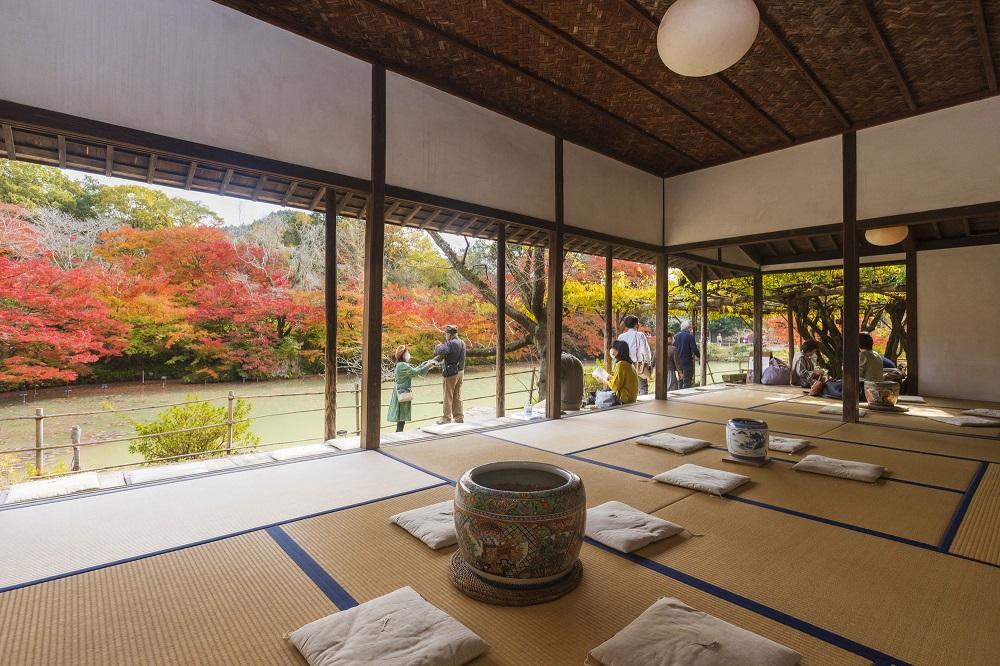
The vast garden at the foot of Mt! The garden is the former villa of Shigeyoshi Nabeshima, lord of Takeo, and was created in 1845 at the end of the Edo period. Today, the garden is planted with approximately 200,000 azaleas, wisteria, rhododendrons, and other plants, and is designated as a national monument as the "Former Takeo-Ou Lord Nabeshima's Residence Garden. During the fall foliage season, the garden is decorated with autumn leaves centering on a large maple tree that is approximately 170 years old. The autumn foliage and yellow leaves can be enjoyed against the backdrop of the precipitous cliffs of Mt. During the autumn foliage season, the area is illuminated at night, making it one of the largest illuminated areas in Japan. (Photo provided by Saga Prefecture Tourism Federation)
| Location | 4100 Oaza Takeo, Takeo Town, Takeo City, Saga Prefecture, Japan |
|---|---|
| phone | 0954-23-3131 Opening Period October 10, 2022 (Monday) - November 6, 2022 (Sunday) |
| opening hours (of a park, etc.) | 17:00-22:30 Admission: Adults: 1,200 yen on weekdays, 1,600 yen on weekends and holidays; Junior and senior high school students: 800 yen on weekdays, 1,000 yen on weekends and holidays; Elementary school students: 600 yen on weekdays, 800 yen on weekends and holidays; Preschoolers: free |
| Access | 11 minutes from |
| supplementary information | Related URL:. Mifuneyama Rakuen official website Roadside Station Yamauchi |
We introduced recommended autumn foliage spots that can be easily reached from the roadside station.
We hope you will find it useful for your fall trip.


